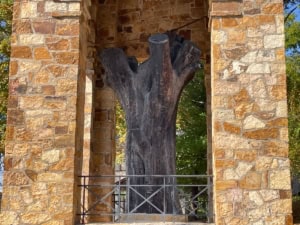Indiana Admitted as the 19th State
(This history is not intended to be a comprehensive or all-inclusive history of the state of Indiana. The History Museum provides this for general knowledge about Indiana’s history.)
 Following the Indian troubles and the War of 1812, the Indiana Territory was ready for statehood. A main figure in Indiana’s road to statehood was Jonathan Jennings. Born in New Jersey, Jennings was raised in Pennsylvania. Jennings, like many other settlers in the Indiana Territory, came to this area by floating down the Ohio River on a flatboat. Jennings, while in the Indiana Territory, practiced law, sold land and published a newspaper.
Following the Indian troubles and the War of 1812, the Indiana Territory was ready for statehood. A main figure in Indiana’s road to statehood was Jonathan Jennings. Born in New Jersey, Jennings was raised in Pennsylvania. Jennings, like many other settlers in the Indiana Territory, came to this area by floating down the Ohio River on a flatboat. Jennings, while in the Indiana Territory, practiced law, sold land and published a newspaper.
Jonathan Jennings wanted to represent the Indiana people in Congress. He traveled throughout the Indiana Territory campaigning. Most people liked him and elected him to Congress in 1809 and again in 1811.
While in Congress, Jennings petitioned the government for Indiana statehood in 1811. However, when the War of 1812 broke out, this issue was delayed. After the war, however, Congress ordered the officials in the Indiana Territory to take a census of the people living in the territory. The census reported that there were 63,000 adults living within Indiana. This was well above the population number a territory needed for statehood.
In 1816, Jonathan Jennings petitioned Congress for an enabling act. An enabling act was a legal procedure territories followed in order to become states. Congress soon passed the act that set the boundaries of the future state of Indiana. The act also required the new leaders to meet and write a state constitution.
After the Indiana Enabling Act was passed, delegates from within the new state were chosen to attend the state constitutional convention.
In 1813, the Indiana Territorial capital had been moved from the old Indiana Territory city of Vincennes to the city of Corydon, in southern Indiana. The capital was moved because it was a more central location for the settled part of Indiana.
In the summer of 1816, 43 delegates met at Corydon to write a state constitution. They met inside the Harrison County Courthouse, which was sometimes very cramped. So, several times the delegates met outside under a huge elm tree. This tree became known as the Constitutional Elm tree. The trunk of this tree is still preserved in the town of Corydon.
Jonathan Jennings was chosen as the president of the convention. His leadership helped the delegates write a very strong state constitution. The constitution created 3 different parts of the state’s government. The state of Indiana would have a General Assembly that made the laws. A state governor would see that these laws were followed. And the Supreme Court would decide whether the laws passed were fair.
A major argument arose over slavery. Some delegates wanted each community or county to decide if it wanted slaves or not. Others did not want slavery at all. Eventually, after heated debates, slavery was voted to be illegal within the borders of Indiana.
Even though the state constitution was strong, there were still inequalities placed in the document. Women, blacks and Indians could not vote. However, for its time, the Indiana Constitution was well-written. Prior to the constitution, men could not vote unless they owned property. The constitution said that all white men could vote, if they lived within the borders of Indiana.
Indiana was also the first state to start a state-funded public school system. The constitution also set aside one township for a public university. Indiana University in Bloomington was later built in one of these townships.
After the constitution was written, an election was held to determine Indiana’s first governor and members of the General Assembly. Jonathan Jennings was appointed (appointed because someone could not be elected before a territory became a state) as the first governor of Indiana.
Indiana now had a working constitution and state government. On December 11, 1816, Indiana was admitted to the United States as the nineteenth state in the union.
To read the 1816 Indiana State Constitution, CLICK HERE
The Indiana State Constitution was amended and edited in 1851. To read the 1851 Indiana State Constitution, CLICK HERE
Users may download material displayed on this site for noncommercial, educational purposes only, provided all copyright and other proprietary notices contained on the materials are retained. Unauthorized use of the Northern Indiana Historical Society d/b/a The History Museum’s logo and Web site logo is not permitted. The contents of this site may not be used for commercial purposes, without written permission of the Northern Indiana Historical Society d/b/a The History Museum. To obtain permission to reproduce information on this site, submit the specifics of your request in writing to Director of Marketing & Community Relations, The History Museum, 808 West Washington Street, South Bend, Indiana 46601 or If permission is granted, the wording “provided with permission from the The History Museum” and the date must be noted. However, permission is not required to create a link to the The History Museum’s Web site or any pages contained therein.





